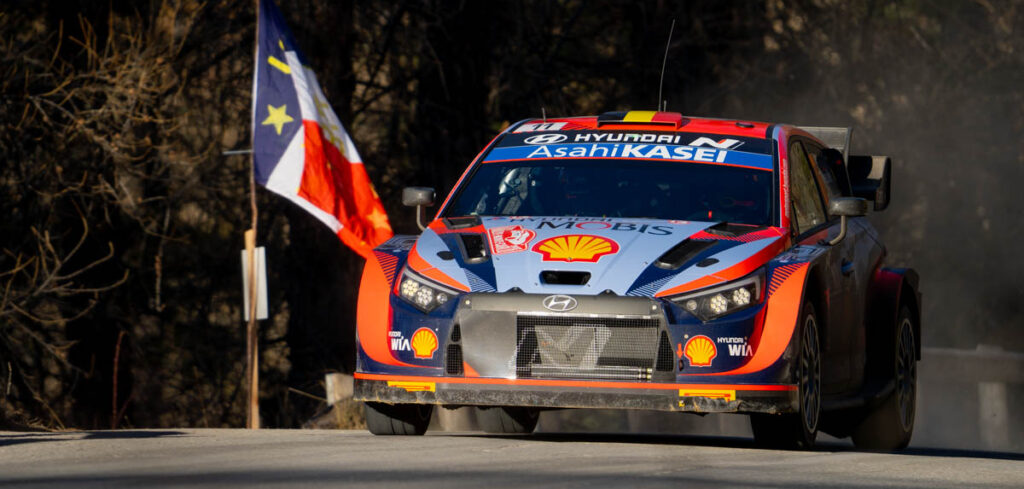As a debut for the all-new Rally1 machinery, Monte Carlo was a resounding success with the cars well received by fans and a battle of the Sébastiens kicking of the 2022 season, even if neither of the protagonists – Ogier and Loeb – plan on running a full championship assault. Watching the cars run through the classic Col de Turini stage on the opening night of the rally, they have certainly lost none of the spectacle that arrived with the last rules shake-up in 2017.
Talking to the technical leads of the three Rally1 manufacturers – Tom Fowler at Toyota, Chris Williams at M-Sport Ford and Julien Moncet at Hyundai (its deputy team principal who is steering the ship following Andrea Adamo’s departure) – it was clear that bringing the new cars to competition had been tough and there remains plenty of scope for further development.
First of all, and brought home both during pre-Monte testing and during the event, the move to tube frame chassis, incorporating a greater number of safety features than the old production car-based WRC machines, has paid off. It seemed the in-vogue approach to crashing was via a ravine or cliff, with Hyundai’s Thierry Neuville pitching his i20 into a river during testing, then M-Sport’s Adrien Fourmaux barrel rolling off a precipice early on the second stage of the Monte.
In both cases, the crews walked away essentially unscathed, and imagery of each crash showed the integrity of the central safety cells remained, as well as that of the hybrid systems. Though there were some complaints from crews about the seating position of the new cars in the lead up to the season, the FIA’s efforts to create more volume between the occupants and the outer edges of the cars appear to be well founded.
This brings us to my second, third and fourth points, all of which center around the hybrid system (a spec unit supplied by Compact Dynamics). Firstly, reliability was by and large good for the system’s competition debut; a couple of drivers had small issues, and some fell foul of the sporting regulations surrounding the hybrid deployment and all-electric use on road stages, but no one suffered a major failure. Speaking to M-Sport’s Williams prior to the event, he was far from convinced this would be the case.
However, Williams and his counterparts at Hyundai and Toyota all admitted that integrating the hybrids within the cars had been challenging, particularly from a cooling perspective. Toyota’s Fowler noted that initially, his engineering team did not think it would be possible to incorporate sufficient cooling capacity (within the constraints of the rules) to accommodate they hybrid’s needs across all rally conditions. However, after an intense development program, he felt they reached around 95% of the capacity required. Notably, each team has taken a very different approach to the cooling integration at the rear of the cars, with various takes on side inlet style and size as well as how the exiting cooling air is handled.
A final point on the hybrid systems is that deployment and regen mapping will be a key development area through the year (within the constraints of having limited homologation periods when new maps can be introduced). Each team is permitted six homologated maps in total, three deployment and three regen, which drivers can switch between stages. However, all of a team’s drivers must use the same maps, meaning there is no scope to tweak them for individual driving styles. In the case of Sébastien Ogier, he was clear that there was work still to be done from Toyota’s perspective. “It is not compromising me in every section, there are some profiles where it is fine and some where I struggle,” he explained after tackling mixed stages of ice and dry tarmac.
The final notable observation to come out of Monte Carlo is that despite having what is effectively a spec central chassis and relatively tight constraints on suspension position and design, the three manufacturers had quite different takes on suspension geometry.
With the previous generation of cars, both M-Sport and Toyota offset their dampers from the axle line front and rear, allowing for a longer unit to be fitted and greater travel to be achieved, even if placing the damper off axis was less than ideal from a friction perspective. Hyundai, meanwhile, always ran its dampers in-line with the axle. For the new Rally1 era the situation is reversed, with Hyundai aggressively offsetting and angling its dampers, while M-Sport and Toyota have placed them in-line.
When asked about Toyota’s approach, Fowler explained that now travel was limited to 270mm (it was previously unlimited with at least Toyota and M-Sport running well over 300mm), “one of the first questions that our suspension design team was asked to answer during the very early concept stages, was ‘Okay, we’re going to limit the travel to roughly x, can you fit a strut on top of the driveshaft without offsetting it, and have still had the maximum travel?’ After some work, the answer was yes. So that’s where it went”.
Clearly, Hyundai had different ideas and, though more than likely unrelated, did suffer suspension reliability issues when Thierry Neuville had a front damper punch through its top mount on a stage, necessitating a creative roadside fix to keep him in the rally.
Based on the first rally of the year, Ford and Toyota appear evenly matched, while Hyundai has clearly suffered from a lack of development – you never want you lead driver describing the car as the scariest they ever driven, which is how Neuville felt after the opening stages. However, it is early days for the Rally1 machines and with development jokers still to be used through the year, no doubt the balance of power will shift as the season progresses.



